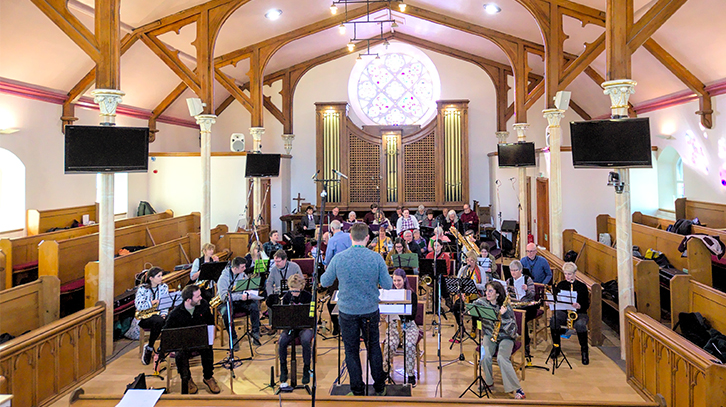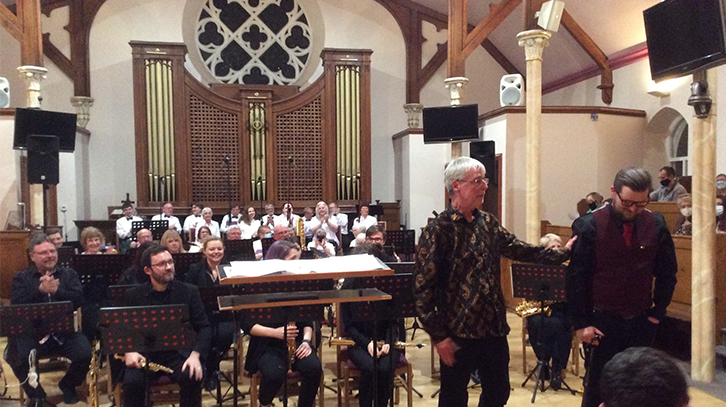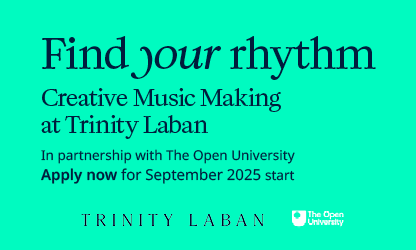Adopt a Music Creator blog: A grand finale
Ben Lunn looks back at the last 16 months of socially-distanced rehearsals, Zoom videos, bell caps, face masks, and a storm that nearly stranded the conductor in Heathrow - culminating in the Ugie Voices and Aberdeenshire Saxophone Orchestra recording and performing his work, 'Rhymes and Recollections'.
When I was initially adopted by the choir and saxophones, the staff of Making Music told us - 'This is not an ordinary commission…'. This turned out to be quite the understatement considering the challenges, various adaptions, and clever tactics we had to implement to work around the chaos the world has been in since the pandemic started in 2020.
To get a full picture of the process, it is probably wise to talk about the wider community and place of the ensembles I was teamed up with. As their title suggests, the saxophone orchestra are based in Aberdeenshire and have members coming together once a month from across various corners of the spacious Northern County. Ugie Voices have a very similar make-up; however, they rehearse weekly. Both had their own challenges at the height of the pandemic. The saxophone orchestra had managed to cope with the ‘new normal’ incredibly well, even managing to work with the English-based Phoenix Saxophone Orchestra and getting nominated for awards from the Royal Philharmonic Society. For Ugie Voices, the challenge of Zoom rehearsals was far more complex, which is certainly not a flaw - so few ensembles were able to tackle this challenge, and ultimately everyone was simply desperate to return to rehearsing together in person.
'This is not an ordinary commission…'
Aberdeenshire, like all corners of Britain, has a curious and unique history that is often overlooked by national stereotypes. This includes folk tales deeply entwined with the make-up of the environment and the communities that flourished there, a unique dialect, a colloquial musical tradition, and a personal history with its own legends, heroes and villains. For many members of both groups and myself, dialect was quite the draw. Coming from Sunderland, it's hard to find my own accent in classical music (to such an extent that when composing a song cycle called 'Sangs from Hyme', I had to act as a language coach to the singer I worked with). The other draw that comes from exploring local dialects is that it can be an avenue to hear things from ordinary people, instead of the wealthy who have often forgone their accent to speak more like the king or queen. That being said, Scots and Doric do also have a long tradition of texts about lairds, kings, and other rulers whom I have very little interest in (to put it delicately).
After lots of searching, I came across a wonderful poetry anthology called 'The Poorhouse Fugitives', which features 19th century poetry either from working-class or progressive individuals, often closely associated with the Chartist movement. Within that book, I came across William Thom, 'The Inverury Poet'. The first poems I read were fascinating, as they are obviously in dialect, but also came from a place that depicts the reality of life in Aberdeenshire – not in a patronising ‘life is hard, but the locals keep smiling’ way, but in a way that shows beauty in the environment, the realities and toils of labour, and the dangers of life. In the book, it mentioned the poems I read came from a larger work by Thom called 'Rhymes and Recollections'.
'... came from a place that depicts the reality of life in Aberdeenshire – not in a patronising ‘life is hard, but the locals keep smiling’ way, but in a way that shows beauty in the environment, the realities and toils of labour, and the dangers of life.'
Once I found that book, I was very quickly swept up by what the piece could be. With so many texts, it was hard to focus on just one, and - out of sheer enthusiasm - I seemed to keep adding more songs to the collection. Throughout the choices of texts, I wanted to keep the same kind of balance which Thom managed to demonstrate – avoiding an idealistic picture of the past/county, while refusing to wallow too much in sorrow and grief.
So once the text was found, the next and greatest challenge was: what on earth does the music sound like? A continual problem for composers, but in this instance, it was quite a curious problem – namely, how do I musically add something locally without descending into twee folk quotations? The answer came in the form of a hymn called 'Crimond'. There's a lot of back-and-forth about who actually wrote it, but all assert that the melody came from Aberdeenshire. So, the melody had to appear in some form. My final choice was to use it as a frame to round off the collection of songs: to start from it as a point of reference and to eventually return. What made this even more possible was that I found William Thom’s 'Monitor’s Song' had the same syllabic structure as 'Crimond'. It certainly felt like a moment of fate – or at least some form of serendipity.
'It certainly felt like a moment of fate – or at least some form of serendipity.'
The next major challenge was how to address the elephant in the room – one enthusiastic saxophone can deafen a choir, so how on earth do you balance a choir and saxophone ensemble where the saxes outnumber the choir by three to two? One solution was technological magic, which simply amplified the choir. This was nice, but if I just resorted to that, we wouldn’t really get to hear the nature and character of each group. So, through the numerous movements that existed, I played around with the set-up - with the last four sections avoiding the full ensemble entirely, as I opted for bass sax and choir, sax quartet and choir, high saxes and choir, low saxes and choir. Similarly, the choir (like many choirs across Britain) had a larger section of sopranos and altos, meaning it felt necessary to have a movement with just them singing with the saxes. Alongside all of this, because the saxes had to be reined in to aid the choir, I created a prelude, which was a nice chance for the ensemble to let rip a little bit more - as well as serving as a hint of how the harmonic language of the whole work would pan out.
So, after composing the beast, the final hurdle was to perform it. Obviously, in pre-Covid times, this was simply a worry about keeping rehearsals strong and effective and so on – as well as being encouraging enough to make sure the ensemble in question does not come to despise you for putting mean notes in front of them. However, dealing with Covid, this meant early rehearsals (June 2021) had to be distanced and outdoors, or distanced but indoors, then less distanced, and eventually to a manageable degree. This obviously had an impact in numerous ways: one, because hearing your colleagues in the ensemble is warped as a result, and two, because rehearsals rarely happened without someone isolating at home. However, through a mixture of tenacity, stubbornness, and committees working like they were organising a military operation, both ensembles found their own way through it. This included midi renditions of every part so everyone could rehearse at home, language lessons from the resident Doric expert Gordon, and me jumping in to give the basses what support I could. It certainly encourages people if the composer can sing their own piece.

Ben Lunn conducting the Ugie Voices and Aberdeenshire Saxophone Orchestra at the Acorn Centre on recording day. Photo credit: Christian Stölte
The recording was an entertaining challenge for everyone (with the exception of myself and Richard), because using recording time is an alien concept. In the rehearsals leading up to the big day, Richard described what the process would be like. On top of that, we had the fun Eunice storm, which stranded Richard at Heathrow, meaning I had to jump in and lead the recording session until he finally managed to fly to Northern Scotland. As a very dedicated member of the tenor saxes had gone to rescue Richard from Inverness airport, the recording was shaped in a way that did not feature the tenor saxes too heavily, so as not to leave the heroic driving sax out of the recording. From there, when Richard finally arrived, I jumped into the choir to sing along – I’m unsure how often there have been recordings of works in which some of it is conducted by the composer, while at other points, the composer is singing along in the same recording.
The concert on Saturday 26 March was quite the sensation, because I have never worked on a piece quite so intensely with the same ensemble. Many workshops tend to be a year at most, so to have nearly two years to get to know everyone, to scheme, and to think really made the piece particularly special. Everyone outdid themselves. I’m a very happy composer, and I’m really excited for the day I’ll be able to share the recording. Until then, I just need to work out what to do with myself now I don’t have the monthly trip to Inverurie.

Ben Lunn takes a bow alongside MD Richard Ingham at the premiere on 26 March
Follow Aberdeenshire Saxophone Orchestra on Facebook / Instagram, Ben Lunn on Facebook / Twitter and Ugie Voices on Facebook / Twitter
The Adopt a Music Creator project matches vocal and instrumental leisure-time music groups with some of the UK’s most promising music creators to collaborate on creating a new piece of music. The project leads to a premiere performance and broadcast on BBC Radio 3. If you’re a music group or music creator and you’d like to take part, find out more.



